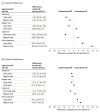Effects of Cuff Size on the Accuracy of Blood Pressure Readings: The Cuff(SZ) Randomized Crossover Trial
- PMID: 37548984
- PMCID: PMC10407761
- DOI: 10.1001/jamainternmed.2023.3264
Effects of Cuff Size on the Accuracy of Blood Pressure Readings: The Cuff(SZ) Randomized Crossover Trial
Abstract
Importance: Clinical practice guidelines recommend selecting an appropriately sized cuff based on mid-arm circumference prior to measuring blood pressure (BP). To our knowledge, the effect of miscuffing on BP measurement when using an automated BP device has not been quantified.
Objective: To determine the effect of using a regular BP cuff vs an appropriately sized BP cuff on automated BP readings.
Design, setting, and participants: This randomized crossover trial of community-dwelling adults with a wide range of mid-arm circumferences took place between March 16 and October 25, 2021, in Baltimore, Maryland. Participants were recruited via BP screening events at a public food market and a senior housing facility, targeted mailings to prior research participants, placement of study brochures in hypertension clinics at Johns Hopkins University, and referrals from physicians providing hypertension care to adults.
Interventions: Participants underwent 4 sets of triplicate BP measurements, with the initial 3 sets using an appropriate, too-small, or too-large BP cuff in random order; the fourth set of triplicate measurements was always completed with an appropriate BP cuff.
Main outcomes and measures: The primary outcome was the difference in mean BP when measured with a regular BP cuff compared with an appropriate BP cuff. The secondary outcome was the difference in BP when using too-small or too-large BP cuffs vs an appropriate BP cuff across all cuff sizes. Results were also stratified by systolic BP (≥130 mm Hg vs <130 mm Hg) and body mass index (calculated as weight in kilograms divided by height in meters squared; ≥30 vs <30).
Results: A total of 195 adults (mean [SD] age, 54 [16] years; 67 [34%] male; 132 [68%] Black; 100 [51%] with hypertension) were randomized for inclusion. Among individuals requiring a small BP cuff, use of a regular BP cuff resulted in a statistically significant lower BP reading (mean systolic BP difference, -3.6 [95% CI, -5.6 to -1.7] mm Hg). In contrast, among individuals requiring a large or extra-large BP cuff, use of a regular BP cuff resulted in a statistically significant higher BP reading (mean systolic BP difference, 4.8 [95% CI, 3.0-6.6] mm Hg and 19.5 [95% CI, 16.1-22.9] mm Hg, respectively). For the secondary outcome, BP differences with overcuffing and undercuffing by 1 and 2 cuff sizes were greater among those requiring larger BP cuffs. The results were consistent in stratified analyses by systolic BP and body mass index.
Conclusions and relevance: In this randomized crossover trial, miscuffing resulted in strikingly inaccurate BP measurements. This is particularly concerning for settings where 1 regular BP cuff size is routinely used in all individuals, regardless of arm size. A renewed emphasis on individualized BP cuff selection is warranted.
Trial registration: ClinicalTrials.gov Identifier: NCT04610775.
Conflict of interest statement
Figures



Comment in
-
There Is No 1-Size-Fits-All to Blood Pressure Measurement-Cuff Size Matters.JAMA Intern Med. 2023 Oct 1;183(10):1069-1070. doi: 10.1001/jamainternmed.2023.3277. JAMA Intern Med. 2023. PMID: 37548981 Free PMC article. No abstract available.
References
-
- Hypertension. World Health Organization . Accessed June 29, 2023. https://www.who.int/news-room/fact-sheets/detail/hypertension
Publication types
MeSH terms
Associated data
LinkOut - more resources
Full Text Sources
Medical

